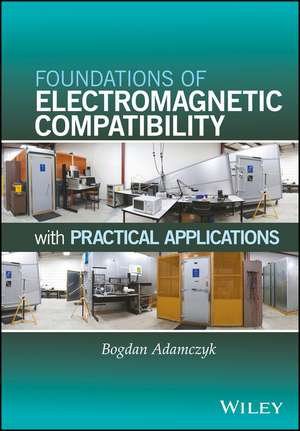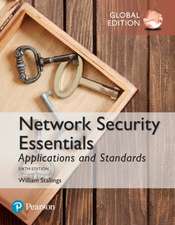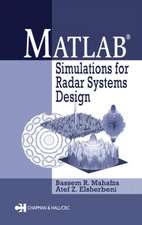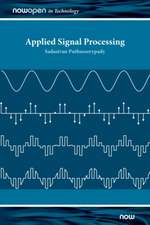Foundations of Electromagnetic Compatibility with Practical Applications
Autor B Adamczyken Limba Engleză Hardback – 20 apr 2017
The book is split into three parts: Part 1 is the refresher course in the underlying mathematics; Part 2 is the foundational chapters in electrical circuit theory; Part 3 is the heart of the book: electric and magnetic fields, waves, transmission lines and antennas. Each part of the book provides an independent area of study, yet each is the logical step to the next area, providing a comprehensive course through each topic. Practical EMC applications at the end of each chapter illustrate the applicability of the chapter topics. The Appendix reviews the fundamentals of EMC testing and measurements.
Preț: 815.57 lei
Preț vechi: 896.23 lei
-9% Nou
156.06€ • 163.37$ • 129.13£
Carte tipărită la comandă
Livrare economică 05-19 aprilie
Specificații
ISBN-10: 1119120780
Pagini: 648
Dimensiuni: 170 x 244 x 36 mm
Greutate: 1.11 kg
Editura: Wiley
Locul publicării:Chichester, United Kingdom
Public țintă
Primary: EMC practitioners, engineers, techniciansSecondary: EMC managers, Undergraduate students on Electrical Engineering courses, practitioners with a non– electrical engineering degree
Descriere
There is currently no single book that covers the mathematics, circuits, and electromagnetics backgrounds needed for the study of electromagnetic compatibility (EMC). This book aims to redress the balance by focusing on EMC and providing a background in all three disciplines. This background is necessary for many EMC practitioners who have been out of study for some time and who are attempting to follow and confidently utilize more advanced EMC texts.
The book is split into three parts: Part I is a refresher course in the underlying mathematics; Part II provides the foundational concepts of electrical circuit theory; Part III is the heart of the book: electric and magnetic fields, waves, transmission lines, and antennas. Each part of the book provides an independent area of study, yet each is the logical step to the next area, providing a comprehensive course through each topic. Practical EMC applications at the end of each chapter illustrate the applicability of the chapter topics. The appendix reviews the fundamentals of EMC testing and measurements.
This book:
- is unique in packaging the three key topics of mathematics, circuits, and electromagnetics foundations into one comprehensive reference
- is supported by each chapter′s practical EMC applications, which illustrate the applicability of the topics
- has an appendix reviewing the fundamentals of EMC testing and measurements
- refreshes the mathematical and circuits skills of the EMC engineer
- has useful support texts for those undertaking self–study or attempting to follow more advanced EMC texts.
Textul de pe ultima copertă
There is currently no single book that covers the mathematics, circuits, and electromagnetics backgrounds needed for the study of electromagnetic compatibility (EMC). This book aims to redress the balance by focusing on EMC and providing a background in all three disciplines. This background is necessary for many EMC practitioners who have been out of study for some time and who are attempting to follow and confidently utilize more advanced EMC texts.
The book is split into three parts: Part I is a refresher course in the underlying mathematics; Part II provides the foundational concepts of electrical circuit theory; Part III is the heart of the book: electric and magnetic fields, waves, transmission lines, and antennas. Each part of the book provides an independent area of study, yet each is the logical step to the next area, providing a comprehensive course through each topic. Practical EMC applications at the end of each chapter illustrate the applicability of the chapter topics. The appendix reviews the fundamentals of EMC testing and measurements.
This book:
- is unique in packaging the three key topics of mathematics, circuits, and electromagnetics foundations into one comprehensive reference
- is supported by each chapter′s practical EMC applications, which illustrate the applicability of the topics
- has an appendix reviewing the fundamentals of EMC testing and measurements
- refreshes the mathematical and circuits skills of the EMC engineer
- has useful support texts for those undertaking self–study or attempting to follow more advanced EMC texts.
Cuprins
Preface xiii
Part I Math Foundations of EMC 1
1 Matrix and Vector Algebra 3
1.1 Basic Concepts and Operations 3
1.2 Matrix Multiplication 5
1.3 Special Matrices 6
1.4 Matrices and Determinants 7
1.5 Inverse of a Matrix 9
1.6 Matrices and Systems of Equations 10
1.7 Solution of Systems of Equations 11
1.8 Cramer s Rule 12
1.9 Vector Operations 13
1.10 EMC Applications 14
References 21
2 Coordinate Systems 23
2.1 Cartesian Coordinate System 23
2.2 Cylindrical Coordinate System 25
2.3 Spherical Coordinate System 27
2.4 Transformations between Coordinate Systems 29
2.5 EMC Applications 33
References 35
3 Vector Differential Calculus 37
3.1 Derivatives 37
3.2 Differential Elements 40
3.3 Constant ]Coordinate Surfaces 45
3.4 Differential Operators 50
3.5 EMC Applications 55
References 57
4 Vector Integral Calculus 59
4.1 Line Integrals 59
4.2 Surface Integrals 66
4.3 Volume Integrals 71
4.4 Divergence Theorem of Gauss 71
4.5 Stokes s Theorem 71
4.6 EMC Applications 72
References 79
5 Differential Equations 81
5.1 First Order Differential Equations RC and RL Circuits 81
5.2 Second ]Order Differential Equations Series and Parallel RLC Circuits 85
5.3 Helmholtz Wave Equations 95
5.4 EMC Applications 99
References 108
6 Complex Numbers and Phasors 109
6.1 Definitions and Forms 109
6.2 Complex Conjugate 111
6.3 Operations on Complex Numbers 113
6.4 Properties of Complex Numbers 118
6.5 Complex Exponential Function 118
6.6 Sinusoids and Phasors 119
6.7 EMC Applications 123
References 140
Part II Circuits Foundations of EMC 141
7 Basic Laws and Methods of Circuit Analysis 143
7.1 Fundamental Concepts 143
7.2 Laplace Transform Basics 147
7.3 Fundamental Laws 152
7.4 EMC Applications 183
References 187
8 Systematic Methods of Circuit Analysis 189
8.1 Node Voltage Analysis 189
8.2 Mesh Current Analysis 192
8.3 EMC Applications 195
References 202
9 Circuit Theorems and Techniques 203
9.1 Superposition 203
9.2 Source Transformation 207
9.3 Thévenin Equivalent Circuit 211
9.4 Norton Equivalent Circuit 217
9.5 Maximum Power Transfer 220
9.6 Two ]Port Networks 224
9.7 EMC Applications 236
References 241
10 Magnetically Coupled Circuits 243
10.1 Self and Mutual Inductance 243
10.2 Energy in a Coupled Circuit 248
10.3 Linear (Air ]Core) Transformers 250
10.4 Ideal (Iron ]Core) Transformers 251
10.5 EMC Applications 255
References 258
11 Frequency ]Domain Analysis 259
11.1 Transfer Function 259
11.2 Frequency ]Transfer Function 267
11.3 Bode Plots 272
11.4 Passive Filters 277
11.5 Resonance in RLC Circuits 294
11.6 EMC Applications 308
References 327
12 Frequency Content of Digital Signals 329
12.1 Fourier Series and Frequency Content of Signals 329
12.2 EMC Applications 347
References 351
Part III Electromagnetics Foundations of EMC 353
13 Static and Quasi ]Static Electric Fields 355
13.1 Charge Distributions 355
13.2 Coulomb s Law 356
13.3 Electric Field Intensity 357
13.4 Electric Field Due to Charge Distributions 358
13.5 Electric Flux Density 359
13.6 Gauss s Law for the Electric Field 360
13.7 Applications of Gauss s Law 360
13.8 Electric Scalar Potential and Voltage 367
13.9 Voltage Calculations due to Charge Distributions 369
13.10 Electric Flux Lines and Equipotential Surfaces 373
13.11 Maxwell s Equations for Static Electric Field 374
13.12 Capacitance Calculations of Structures 374
13.13 Electric Boundary Conditions 380
13.14 EMC Applications 385
References 402
14 Static and Quasi ]Static Magnetic Fields 403
14.1 Magnetic Flux Density 403
14.2 Magnetic Field Intensity 404
14.3 Biot Savart Law 404
14.4 Current Distributions 405
14.5 Ampere s Law 406
14.6 Applications of Ampere s Law 407
14.7 Magnetic Flux 409
14.8 Gauss s Law for Magnetic Field 410
14.9 Maxwell s Equations for Static Fields 410
14.10 Vector Magnetic Potential 411
14.11 Faraday s Law 412
14.12 Inductance Calculations of Structures 416
14.13 Magnetic Boundary Conditions 418
References 437
15 Rapidly Varying Electromagnetic Fields 439
15.1 Eddy Currents 439
15.2 Charge ]Current Continuity Equation 440
15.3 Displacement Current 441
15.4 EMC Applications 444
References 452
16 Electromagnetic Waves 453
16.1 Uniform Waves Time Domain Analysis 453
16.2 Uniform Waves Sinusoidal Steady ]State Analysis 460
16.3 Reflection and Transmission of Uniform Waves at Boundaries 464
16.4 EMC Applications 467
References 474
17 Transmission Lines 475
17.1 Transient Analysis 475
17.2 Steady ]State Analysis 509
17.3 s Parameters 520
17.4 EMC Applications 527
References 542
18 Antennas and Radiation 543
18.1 Bridge between the Transmission Line and Antenna Theory 543
18.2 Hertzian Dipole Antenna 544
18.3 Far Field Criteria 548
18.4 Half ]Wave Dipole Antenna 551
18.5 Quarter ]Wave Monopole Antenna 554
18.6 Image Theory 554
18.7 Differential ] and Common ]Mode Currents and Radiation 557
18.8 Common Mode Current Creation 565
18.9 Antenna Circuit Model 571
18.10 EMC Applications 575
References 582
Appendix A EMC Tests and Measurements 583
A.1 Introduction FCC Part 15 and CISPR 22 Standards 583
A.2 Conducted Emissions 588
A.3 Radiated Emissions 600
A.4 Conducted Immunity ISO 11452 ]4 608
A.5 Radiated Immunity 615
A.6 Electrostatic Discharge (ESD) 620
References 627
Index 629
Notă biografică
About the Author
Bogdan Adamczyk is Professor of Engineering and the founder and director of the EMC Center at Grand Valley State University, Grand Rapids, USA. He is also the founder and principal educator of EMC Educational Services LLC, which specializes in EMC courses for industry. Professor Adamczyk′s area of expertise is EMC education and EMC pre–compliance testing.
He is an iNARTE–certified EMC Master Design Engineer, a founding member and the chair of the IEEE EMC Chapter of West Michigan, and a member of the IEEE EMC Society Education Committee. He was a 2016 IEEE EMC Symposium Global University and Fundamentals of EMC instructor. This book has evolved from his participation at several IEEE EMC Symposia, EMC pre–compliance testing at the EMC Center, and his teaching of the Foundations of Electromagnetic Compatibility certificate courses for industry.

















